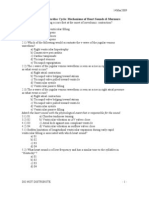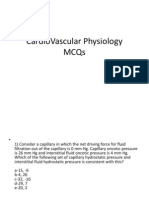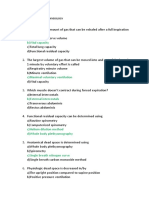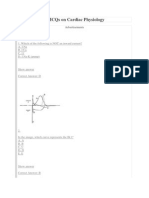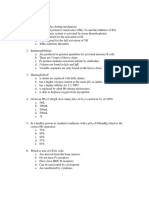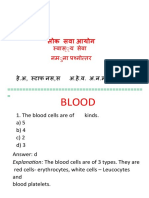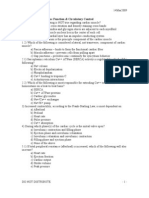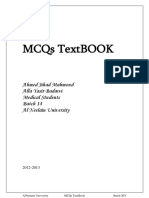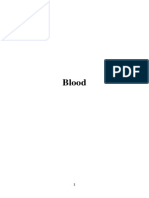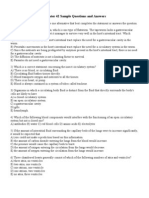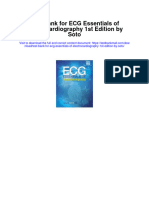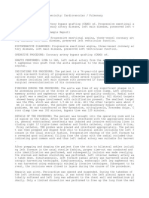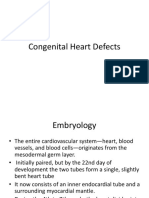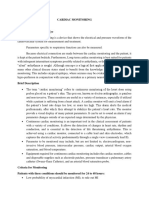Professional Documents
Culture Documents
14 Test Bank Cardiovascular Physiology MCQ Test Bank With Answers
14 Test Bank Cardiovascular Physiology MCQ Test Bank With Answers
Uploaded by
mugtabaOriginal Title
Copyright
Available Formats
Share this document
Did you find this document useful?
Is this content inappropriate?
Report this DocumentCopyright:
Available Formats
14 Test Bank Cardiovascular Physiology MCQ Test Bank With Answers
14 Test Bank Cardiovascular Physiology MCQ Test Bank With Answers
Uploaded by
mugtabaCopyright:
Available Formats
lOMoARcPSD|12324991
14 test bank - Cardiovascular Physiology MCQ test bank with
answers
Human Body Systems (University of Saskatchewan)
StuDocu is not sponsored or endorsed by any college or university
Downloaded by mujtaba Azhari ([email protected])
lOMoARcPSD|12324991
Human Physiology: An Integrated Approach, 7e, (Silverthorn)
Chapter 14 Cardiovascular Physiology
1) In the 16th century, William Harvey discovered evidence that
A) the cardiovascular system transports blood and air.
B) the cardiovascular system is an open system.
C) arteries and veins are linked by capillaries.
D) blood is recirculated instead of consumed.
E) the liver manufactures blood.
Answer: D
Section: Overview of the Cardiovascular System
Learning Outcome: 14.1
Bloom's Taxonomy: Knowledge
2) Capillaries are best described as
A) microscopic vessels in which blood exchanges material with the interstitial fluid.
B) thick walled vessels that convey blood away from the heart.
C) thin walled vessels that convey blood toward the heart.
D) thick walled vessels that carry blood rich in oxygen.
E) thin walled vessels that carry blood deficient in oxygen.
Answer: A
Section: Overview of the Cardiovascular System
Learning Outcome: 14.2
Bloom's Taxonomy: Knowledge
3) The most accurate definition of artery is a vessel that
A) carries highly oxygenated blood.
B) contains smooth muscle in its wall.
C) transports blood away from the heart.
D) transports blood toward the heart.
E) contains internal valves.
Answer: C
Section: Overview of the Cardiovascular System
Learning Outcome: 14.2
Bloom's Taxonomy: Knowledge
4) The purpose of having valves in the cardiovascular system is to
A) provide sounds so that heart health can be monitored.
B) ensure that blood flows in one direction.
C) prevent blood from flowing too quickly.
D) regulate blood pressure.
E) provide the force for circulation.
Answer: B
Section: Overview of the Cardiovascular System
Learning Outcome: 14.2
Bloom's Taxonomy: Knowledge
1
Copyright © 2016 Pearson Education, Ltd.
Downloaded by mujtaba Azhari ([email protected])
lOMoARcPSD|12324991
5) Which organ is NOT known to include a special portal system for blood?
A) heart
B) kidney
C) liver
D) brain
E) All of these organs have portal systems.
Answer: A
Section: Overview of the Cardiovascular System
Learning Outcome: 14.2
Bloom's Taxonomy: Knowledge
6) Which artery/arteries branch(es) is/are most proximal to the beginning of the aorta at the
heart?
A) hepatic
B) renal
C) coronary
D) carotid
E) pulmonary
Answer: C
Section: Overview of the Cardiovascular System
Learning Outcome: 14.2
Bloom's Taxonomy: Knowledge
7) The hepatic portal vein carries blood away from the
A) digestive tract.
B) liver.
C) kidneys.
D) spleen.
E) pancreas.
Answer: A
Section: Overview of the Cardiovascular System
Learning Outcome: 14.2
Bloom's Taxonomy: Knowledge
8) The driving force for blood flow is a(n) ________ gradient.
A) osmotic
B) volume
C) pressure
D) gravity
Answer: C
Section: Pressure, Volume, Flow, and Resistance
Learning Outcome: 14.3
Bloom's Taxonomy: Knowledge
2
Copyright © 2016 Pearson Education, Ltd.
Downloaded by mujtaba Azhari ([email protected])
lOMoARcPSD|12324991
9) Which of the following statements about hydrostatic pressure is NOT true?
A) If a fluid is not moving, the pressure that it exerts is called hydrostatic pressure.
B) Force is not equal in all directions.
C) The lateral pressure component of moving fluid represents the hydrostatic pressure.
D) Hydrostatic pressure does not include the dynamic component of a moving fluid.
E) All of the statements are true.
Answer: B
Section: Pressure, Volume, Flow, and Resistance
Learning Outcome: 14.3
Bloom's Taxonomy: Comprehension
10) Each of the following changes will result in increased blood flow to a tissue EXCEPT one.
Identify the exception.
A) increased blood volume
B) decreased vessel diameter
C) increased blood pressure
D) decreased peripheral resistance
E) relaxation of precapillary sphincters
Answer: B
Section: Pressure, Volume, Flow, and Resistance
Learning Outcome: 14.3
Bloom's Taxonomy: Comprehension
11) Which parameters are associated with increased resistance?
A) reduced flow
B) reduced friction
C) increased blood vessel diameter
D) decreased viscosity
E) decreased length
Answer: A
Section: Pressure, Volume, Flow, and Resistance
Learning Outcome: 14.3
Bloom's Taxonomy: Knowledge
12) As blood vessel length increases,
A) resistance increases only.
B) flow decreases only.
C) friction decreases only.
D) resistance increases and flow decreases.
E) both resistance and flow increase.
Answer: D
Section: Pressure, Volume, Flow, and Resistance
Learning Outcome: 14.3
Bloom's Taxonomy: Knowledge
3
Copyright © 2016 Pearson Education, Ltd.
Downloaded by mujtaba Azhari ([email protected])
lOMoARcPSD|12324991
13) Which of the following will increase flow in a vessel the most?
A) decrease length by 1 unit
B) increase radius by 1 unit
C) decrease viscosity by 1 unit
D) All have the same effect on flow.
Answer: B
Section: Pressure, Volume, Flow, and Resistance
Learning Outcome: 14.3
Bloom's Taxonomy: Comprehension
14) When a quantity is expressed as "4 cm/sec," what is being described is the
A) flow rate.
B) velocity of flow.
C) pressure.
D) pressure gradient.
E) volume.
Answer: B
Section: Pressure, Volume, Flow, and Resistance
Learning Outcome: 14.3
Bloom's Taxonomy: Knowledge
15) The sac around the heart is the
A) peritoneum.
B) pleural sac.
C) pericardium.
D) myocardium.
E) epicardium.
Answer: C
Section: Cardiac Muscle and the Heart
Learning Outcome: 14.4
Bloom's Taxonomy: Knowledge
16) The function of the pericardial fluid is to
A) provide oxygen to the heart.
B) reduce friction between the heart and the pericardium.
C) provide fuel to the heart.
D) remove waste products from the heart.
E) store calcium for the heart.
Answer: B
Section: Cardiac Muscle and the Heart
Learning Outcome: 14.4
Bloom's Taxonomy: Knowledge
4
Copyright © 2016 Pearson Education, Ltd.
Downloaded by mujtaba Azhari ([email protected])
lOMoARcPSD|12324991
17) At an intercalated disc,
A) the cell membranes of two cardiac muscle fibers are completely separated by a synapse.
B) the myofibrils are loosely attached to the membrane of the disc.
C) two cardiac muscle cells are connected by gap junctions.
D) t-tubules unite the membranes of the adjoining cells.
E) All of the answers are correct.
Answer: C
Section: Cardiac Muscle and the Heart
Learning Outcome: 14.5
Bloom's Taxonomy: Knowledge
18) In the heart, valves are located
A) just between the atria and the ventricles.
B) just between the ventricles and the arteries.
C) just between the great veins and the atria.
D) between atria and ventricles and between ventricles and arteries.
E) just between the right and left ventricles.
Answer: D
Section: Cardiac Muscle and the Heart
Learning Outcome: 14.4
Bloom's Taxonomy: Knowledge
19) Which valves have chordae tendineae?
A) aortic and pulmonary valves
B) bicuspid (mitral) and tricuspid valves
C) valves in veins
D) semilunar valves
E) coronary valves
Answer: B
Section: Cardiac Muscle and the Heart
Learning Outcome: 14.4
Bloom's Taxonomy: Knowledge
20) The term myogenic indicates that the heart muscle is the source of
A) the contractile force for pumping.
B) a hormone that indirectly regulates blood volume.
C) the electrical signal that triggers heart contraction.
D) receptors that trigger blood pressure reflexes.
E) stem cells that repair damaged heart tissue.
Answer: C
Section: Cardiac Muscle and the Heart
Learning Outcome: 14.6
Bloom's Taxonomy: Knowledge
5
Copyright © 2016 Pearson Education, Ltd.
Downloaded by mujtaba Azhari ([email protected])
lOMoARcPSD|12324991
21) The action potential in a cardiac contractile cell causes
A) opening of L-type calcium channels.
B) opening of ryanodine receptor calcium channels.
C) activation of sodium-potassium ATPase.
D) activation of NCX transporters.
E) opening of HCN channels.
Answer: A
Section: Cardiac Muscle and the Heart
Learning Outcome: 14.7
Bloom's Taxonomy: Knowledge
22) Stretching a myocardial cell
A) only decreases the force of a contraction.
B) only allows more Ca2+ to enter.
C) only increases the force of contraction.
D) decreases the force of a contraction and allows more Ca2+ to enter.
E) allows more Ca2+ to enter and increases the force of a contraction.
Answer: E
Section: Cardiac Muscle and the Heart
Learning Outcome: 14.7
Bloom's Taxonomy: Comprehension
23) The rapid depolarization phase of the action potentials of myocardial contractile cells is due
to which ion(s)?
A) Ca2+ only
B) K+ only
C) Na+ only
D) both Ca2+ and K+
E) both Na+ and K+
Answer: C
Section: Cardiac Muscle and the Heart
Learning Outcome: 14.7
Bloom's Taxonomy: Knowledge
24) During the plateau phase of the action potentials of myocardial contractile cells, which ion(s)
is/are crossing the membrane?
A) Ca2+ only
B) K+ only
C) Na+ only
D) both Ca2+ and K+
E) both Na+ and K+
Answer: D
Section: Cardiac Muscle and the Heart
Learning Outcome: 14.7
Bloom's Taxonomy: Knowledge
6
Copyright © 2016 Pearson Education, Ltd.
Downloaded by mujtaba Azhari ([email protected])
lOMoARcPSD|12324991
25) The flattening of the action potentials of myocardial contractile cells, called the plateau
phase, is due to a combination of ________ K+ permeability and ________ Ca2+ permeability.
A) increasing, increasing
B) decreasing, decreasing
C) increasing, decreasing
D) decreasing, increasing
Answer: D
Section: Cardiac Muscle and the Heart
Learning Outcome: 14.7
Bloom's Taxonomy: Knowledge
26) The action potentials of myocardial autorhythmic cells, are due to a combination of
increasing Na2+ ________ and decreasing K+ ________.
A) influx, efflux
B) efflux, influx
C) influx, influx
D) efflux, efflux
Answer: A
Section: Cardiac Muscle and the Heart
Learning Outcome: 14.7
Bloom's Taxonomy: Knowledge
27) The end of the plateau phase is due to the ________ of Ca2+ channels and ________ of K+
channels.
A) opening, opening
B) closing, closing
C) opening, closing
D) closing, opening
Answer: D
Section: Cardiac Muscle and the Heart
Learning Outcome: 14.7
Bloom's Taxonomy: Knowledge
28) A typical action potential of a myocardial contractile cell lasts ________ millisecond(s).
A) less than 1
B) 1-5
C) 50-100
D) at least 200
E) at least 500
Answer: D
Section: Cardiac Muscle and the Heart
Learning Outcome: 14.7
Bloom's Taxonomy: Knowledge
7
Copyright © 2016 Pearson Education, Ltd.
Downloaded by mujtaba Azhari ([email protected])
lOMoARcPSD|12324991
29) The importance of the plateau phase of the action potential of myocardial cells is in
A) preventing overstretching of the cells.
B) enhancing the efficiency of oxygen use by the cells.
C) preventing tetanus.
D) preventing fibrillation.
E) regulating Ca2+ availability to the cells.
Answer: C
Section: Cardiac Muscle and the Heart
Learning Outcome: 14.7
Bloom's Taxonomy: Comprehension
30) Myocardial cells can generate action potentials spontaneously because they have
A) unstable ion channels.
B) permanently open channels for Na+ and K+.
C) a net influx of Na+.
D) L-type Ca2+ channels.
E) prolonged Ca2+ influx.
Answer: A
Section: Cardiac Muscle and the Heart
Learning Outcome: 14.6
Bloom's Taxonomy: Knowledge
31) If channels are permeable to
A) Na+ only.
B) K+ only.
C) Ca2+ only.
D) Na+ and K+.
E) Ca2+ and K+.
Answer: D
Section: Cardiac Muscle and the Heart
Learning Outcome: 14.6
Bloom's Taxonomy: Knowledge
32) Autorhythmic cells
A) are also called pacemakers because they set the rate of the heartbeat.
B) are the same size as myocardial contractile cells.
C) have organized sarcomeres.
D) contribute to the force of contraction.
E) None of the answers are correct.
Answer: A
Section: Cardiac Muscle and the Heart
Learning Outcome: 14.5
Bloom's Taxonomy: Knowledge
8
Copyright © 2016 Pearson Education, Ltd.
Downloaded by mujtaba Azhari ([email protected])
lOMoARcPSD|12324991
33) The depolarization of the pacemaker action potential spreads to adjacent cells through
A) gap junctions.
B) tight junctions.
C) chemical synapses.
D) desmosomes.
Answer: A
Section: The Heart as a Pump
Learning Outcome: 14.5
Bloom's Taxonomy: Knowledge
34) The fibrous skeleton of the heart is important because it
A) forces electrical activity to be conducted through the atrioventricular node.
B) transmits electrical activity from the atria to the ventricles.
C) helps guide the blood into the proper chambers in sequence.
D) directs the flow of blood into the arteries.
Answer: A
Section: The Heart as a Pump
Learning Outcome: 14.8
Bloom's Taxonomy: Knowledge
35) The AV node is important because it
A) directs electrical impulses from the ventricles to the atria.
B) delays the transmission of the electrical impulses to the ventricles in order for the atria to
finish contracting.
C) serves as the pacemaker in a normal heart.
D) electrically opens the AV valves.
E) None of these answers are correct.
Answer: B
Section: The Heart as a Pump
Learning Outcome: 14.8
Bloom's Taxonomy: Comprehension
36) The medical term for heart attack is
A) heart failure.
B) myocardial infarction.
C) heart murmur.
D) fibrillation.
E) heart block.
Answer: B
Section: The Heart as a Pump
Learning Outcome: 14.8
Bloom's Taxonomy: Knowledge
9
Copyright © 2016 Pearson Education, Ltd.
Downloaded by mujtaba Azhari ([email protected])
lOMoARcPSD|12324991
37) In the condition known as complete heart block, what happens?
A) Coronary arteries are blocked by plaques, preventing blood and oxygen from reaching the
myocardial contractile cells.
B) Electrical signals from the SA node never reach the ventricles, so the contraction of the atria
is not coordinated with the contraction of the ventricles.
C) The fibrous skeleton of the heart breaks down, interfering with the passage of blood from the
atria to the ventricles.
D) The mitral valve leaflets calcify and close, preventing blood from being pumped efficiently
by the left side of the heart.
E) Blood flow through the foramen ovale is blocked.
Answer: B
Section: The Heart as a Pump
Learning Outcome: 14.8
Bloom's Taxonomy: Comprehension
38) When the heart is in fibrillation,
A) the myocardial cells may become damaged from contracting too fast.
B) the myocardial cells deplete their oxygen supply because they are contracting too fast, and the
lactic acid produced damages the myocardial cells.
C) effective pumping of the ventricles ceases because the myocardial cells fail to work as a team,
and the brain cannot get adequate oxygen.
D) the myocardial cells are contracting together as they should; fibrillation indicates a normal
sinus rhythm of 75 beats per minute.
E) there is no contraction of the myocardium.
Answer: C
Section: The Heart as a Pump
Learning Outcome: 14.8
Bloom's Taxonomy: Comprehension
39) Electrical shock to the heart is usually used to treat
A) ventricular fibrillation.
B) atrial fibrillation.
C) heart block.
D) heart murmur.
E) myocardial infarction.
Answer: A
Section: The Heart as a Pump
Learning Outcome: 14.8
Bloom's Taxonomy: Knowledge
10
Copyright © 2016 Pearson Education, Ltd.
Downloaded by mujtaba Azhari ([email protected])
lOMoARcPSD|12324991
40) ECGs
A) provide direct information about the heart function.
B) are most useful in diagnosing heart murmurs.
C) show the summed electrical potentials generated by all cells of the heart.
D) have two major components: waves and nodes.
E) measure the mechanical activity of the heart.
Answer: C
Section: The Heart as a Pump
Learning Outcome: 14.9
Bloom's Taxonomy: Comprehension
41) The P wave of an ECG corresponds to
A) the depolarization of the atria.
B) the progressive wave of ventricular depolarization.
C) the repolarization of the ventricles.
D) atrial repolarization.
E) None of the answers are correct.
Answer: A
Section: The Heart as a Pump
Learning Outcome: 14.9
Bloom's Taxonomy: Knowledge
42) The QRS complex of an ECG corresponds to
A) the depolarization of the atria.
B) the progressive wave of ventricular depolarization.
C) the repolarization of the ventricles.
D) atrial repolarization.
E) None of the answers are correct.
Answer: B
Section: The Heart as a Pump
Learning Outcome: 14.9
Bloom's Taxonomy: Knowledge
43) A heart rate of 125 beats per minute could be correctly termed
A) bradycardia.
B) tachycardia.
C) an arrhythmia.
D) fibrillation.
E) a normal resting heart rate.
Answer: B
Section: The Heart as a Pump
Learning Outcome: 14.9
Bloom's Taxonomy: Knowledge
11
Copyright © 2016 Pearson Education, Ltd.
Downloaded by mujtaba Azhari ([email protected])
lOMoARcPSD|12324991
44) Ventricular contraction
A) begins during the first part of the P wave.
B) begins just after the T wave.
C) begins just after the Q wave.
D) begins during the latter part of the P wave.
E) None of the answers are correct.
Answer: C
Section: The Heart as a Pump
Learning Outcome: 14.9
Bloom's Taxonomy: Knowledge
45) Atrial contraction
A) begins during the first part of the P wave.
B) begins just after the T wave.
C) begins just after the Q wave.
D) begins during the latter part of the P wave.
E) None of the answers are correct.
Answer: D
Section: The Heart as a Pump
Learning Outcome: 14.9
Bloom's Taxonomy: Knowledge
46) In electrocardiography, a lead is a(n)
A) electrode.
B) pair of electrodes.
C) cable that attaches between the ECG machine and the body.
Answer: B
Section: The Heart as a Pump
Learning Outcome: 14.9
Bloom's Taxonomy: Knowledge
47) Which event happens at the start of a cardiac cycle?
A) Blood is ejected from the atrium.
B) The SA node fires.
C) The P wave develops.
D) Ventricular systole occurs.
E) Atrial systole occurs.
Answer: B
Section: The Heart as a Pump
Learning Outcome: 14.10
Bloom's Taxonomy: Comprehension
12
Copyright © 2016 Pearson Education, Ltd.
Downloaded by mujtaba Azhari ([email protected])
lOMoARcPSD|12324991
48) In order for blood to enter the heart,
A) the atria must be in diastole.
B) the pressure in the atria must be lower than in the veins.
C) the AV valves must be open.
D) the atria must not only be at rest but the atrial pressure must be lower than the veins.
E) All of the answers are correct.
Answer: D
Section: The Heart as a Pump
Learning Outcome: 14.10
Bloom's Taxonomy: Knowledge
49) Which of the following events result in the first heart sound?
A) The AV valves open.
B) The AV valves close.
C) The semilunar valves close.
D) The semilunar valves open.
E) The atria contract.
Answer: B
Section: The Heart as a Pump
Learning Outcome: 14.10
Bloom's Taxonomy: Knowledge
50) During the isovolumic phase of ventricular systole,
A) the atria contract.
B) the atrioventricular valves and semilunar valves are closed.
C) blood is ejected into the great vessels.
D) the ventricles are relaxing.
E) the ventricles are filling with blood.
Answer: B
Section: The Heart as a Pump
Learning Outcome: 14.10
Bloom's Taxonomy: Comprehension
51) During the cardiac cycle,
A) the P wave of the ECG occurs between the first and second heart sounds.
B) the QRS complex of the ECG precedes the increase in ventricular pressure.
C) the third heart sound occurs during atrial systole.
D) the second heart sound coincides with the QRS complex of the ECG.
E) the greatest increase in ventricular pressure occurs during the ejection phase.
Answer: B
Section: The Heart as a Pump
Learning Outcome: 14.10
Bloom's Taxonomy: Comprehension
13
Copyright © 2016 Pearson Education, Ltd.
Downloaded by mujtaba Azhari ([email protected])
lOMoARcPSD|12324991
52) During ventricular systole,
A) the atria are contracting.
B) blood is entering the ventricles.
C) the AV valves are closed.
D) the pressure in the ventricles declines.
E) the ventricles are relaxed.
Answer: C
Section: The Heart as a Pump
Learning Outcome: 14.10
Bloom's Taxonomy: Comprehension
53) During ventricular ejection,
A) the ventricles are in systole.
B) the QRS complex is just starting.
C) the semilunar valves are closed.
D) the AV valves are open.
E) blood is forced into veins.
Answer: A
Section: The Heart as a Pump
Learning Outcome: 14.10
Bloom's Taxonomy: Knowledge
54) The term used to describe the amount of blood in the ventricle available to be pumped out of
the heart during the next contraction is
A) cardiac output (CO).
B) heart rate (HR).
C) end-diastolic volume (EDV).
D) stroke volume (SV).
E) end-systolic volume (ESV).
Answer: C
Section: The Heart as a Pump
Learning Outcome: 14.11
Bloom's Taxonomy: Knowledge
55) The volume of blood ejected from each ventricle during a contraction is called the
A) end-diastolic volume.
B) end-systolic volume.
C) stroke volume.
D) cardiac output.
E) cardiac reserve.
Answer: C
Section: The Heart as a Pump
Learning Outcome: 14.11
Bloom's Taxonomy: Knowledge
14
Copyright © 2016 Pearson Education, Ltd.
Downloaded by mujtaba Azhari ([email protected])
lOMoARcPSD|12324991
56) The cardiac output is equal to
A) the difference between the end-diastolic volume and the end-systolic volume.
B) the product of heart rate and stroke volume.
C) the difference between the stroke volume at rest and the stroke volume during exercise.
D) the stroke volume less the end-systolic volume.
E) the product of heart rate and blood pressure.
Answer: B
Section: The Heart as a Pump
Learning Outcome: 14.11
Bloom's Taxonomy: Knowledge
57) The term that describes the volume of blood circulated by the heart in one minute is
A) cardiac output (CO).
B) heart rate (HR).
C) end-diastolic volume (EDV).
D) stroke volume (SV).
E) end-systolic volume (ESV).
Answer: A
Section: The Heart as a Pump
Learning Outcome: 14.11
Bloom's Taxonomy: Knowledge
58) Epinephrine and norepinephrine increase ion flow through ________ channels.
A) Na+ only
B) K+ only
C) Ca2+ only
D) If only
E) If and Ca2+
Answer: E
Section: The Heart as a Pump
Learning Outcome: 14.12
Bloom's Taxonomy: Knowledge
59) According to Starling's law of the heart, the cardiac output is directly related to the
A) size of the ventricle.
B) heart rate.
C) venous return.
D) thickness of the myocardium.
E) end-systolic volume.
Answer: C
Section: The Heart as a Pump
Learning Outcome: 14.13
Bloom's Taxonomy: Comprehension
15
Copyright © 2016 Pearson Education, Ltd.
Downloaded by mujtaba Azhari ([email protected])
lOMoARcPSD|12324991
60) Which of these will increase the heart rate?
A) only sympathetic stimulation to the SA node
B) only the application of epinephrine to the SA node
C) only the application of acetylcholine to the SA node
D) both sympathetic stimulation and application of epinephrine to the SA node
E) both sympathetic stimulation and application of acetylcholine to the SA node
Answer: D
Section: The Heart as a Pump
Learning Outcome: 14.12
Bloom's Taxonomy: Comprehension
61) Stimulation of the beta receptors on heart muscle results in
A) the formation of cAMP.
B) decreased rate of contraction.
C) decreased force of cardiac contraction.
D) increased sensitivity to acetylcholine.
E) All of the answers are correct.
Answer: A
Section: The Heart as a Pump
Learning Outcome: 14.12
Bloom's Taxonomy: Knowledge
62) Drugs known as beta blockers will
A) increase heart rate.
B) decrease heart rate.
C) increase stroke volume.
D) increase cardiac output.
E) decrease the end-systolic volume.
Answer: B
Section: The Heart as a Pump
Learning Outcome: 14.12
Bloom's Taxonomy: Knowledge
16
Copyright © 2016 Pearson Education, Ltd.
Downloaded by mujtaba Azhari ([email protected])
lOMoARcPSD|12324991
Match the following terms to the correct answer:
A. tricuspid valve
B. bicuspid valve
C. aortic valve
D. pulmonary valve
63) an AV valve that has three flaps
Answer: A
Section: Cardiac Muscle and the Heart
Learning Outcome: 14.4
Bloom's Taxonomy: Knowledge
64) a semilunar valve that has the right ventricle on one side
Answer: D
Section: Cardiac Muscle and the Heart
Learning Outcome: 14.4
Bloom's Taxonomy: Knowledge
65) also called the mitral valve
Answer: B
Section: Cardiac Muscle and the Heart
Learning Outcome: 14.4
Bloom's Taxonomy: Knowledge
66) has three cuplike leaflets and has the aorta on one side
Answer: C
Section: Cardiac Muscle and the Heart
Learning Outcome: 14.4
Bloom's Taxonomy: Knowledge
17
Copyright © 2016 Pearson Education, Ltd.
Downloaded by mujtaba Azhari ([email protected])
lOMoARcPSD|12324991
Match the name of the wave with the correlated event.
A. P wave
B. QRS complex
C. T wave
D. PR segment
E. ST segment
67) immediately followed by ventricular contraction
Answer: B
Section: The Heart as a Pump
Learning Outcome: 14.9
Bloom's Taxonomy: Knowledge
68) atrial contraction
Answer: D
Section: The Heart as a Pump
Learning Outcome: 14.9
Bloom's Taxonomy: Knowledge
69) ventricular repolarization
Answer: C
Section: The Heart as a Pump
Learning Outcome: 14.9
Bloom's Taxonomy: Knowledge
70) ventricular depolarization
Answer: B
Section: The Heart as a Pump
Learning Outcome: 14.9
Bloom's Taxonomy: Knowledge
71) atrial depolarization
Answer: A
Section: The Heart as a Pump
Learning Outcome: 14.9
Bloom's Taxonomy: Knowledge
18
Copyright © 2016 Pearson Education, Ltd.
Downloaded by mujtaba Azhari ([email protected])
lOMoARcPSD|12324991
Match each term with its definition.
A. cardiac output (CO)
B. heart rate (HR)
C. end-diastolic volume (EDV)
D. stroke volume (SV)
E. end-systolic volume (ESV)
72) the amount of blood pumped out of the heart during one contraction
Answer: D
Section: The Heart as a Pump
Learning Outcome: 14.10
Bloom's Taxonomy: Knowledge
73) the amount of blood in the ventricle available to be pumped out of the heart during one
contraction
Answer: C
Section: The Heart as a Pump
Learning Outcome: 14.10
Bloom's Taxonomy: Knowledge
74) the volume of blood circulated by the heart in one minute
Answer: A
Section: The Heart as a Pump
Learning Outcome: 14.10
Bloom's Taxonomy: Knowledge
75) the amount of blood left in the ventricle after it contracts
Answer: E
Section: The Heart as a Pump
Learning Outcome: 14.10
Bloom's Taxonomy: Knowledge
76) The chambers of the heart that pump blood into the arteries are the ________.
Answer: ventricles
Section: Cardiac Muscle and the Heart
Learning Outcome: 14.4
Bloom's Taxonomy: Knowledge
77) The chambers of the heart that receive blood from the veins are the ________.
Answer: atria
Section: Cardiac Muscle and the Heart
Learning Outcome: 14.4
Bloom's Taxonomy: Knowledge
19
Copyright © 2016 Pearson Education, Ltd.
Downloaded by mujtaba Azhari ([email protected])
lOMoARcPSD|12324991
78) The primary function of the cardiovascular system is ________.
Answer: to transport material to and from all parts of the body
Section: Overview of the Cardiovascular System
Learning Outcome: 14.1
Bloom's Taxonomy: Knowledge
79) ________ are blood vessels that carry blood away from the heart.
Answer: Arteries
Section: Overview of the Cardiovascular System
Learning Outcome: 14.2
Bloom's Taxonomy: Knowledge
80) ________ are blood vessels that carry blood toward the heart.
Answer: Veins
Section: Overview of the Cardiovascular System
Learning Outcome: 14.2
Bloom's Taxonomy: Knowledge
81) The cardiovascular system is made up of ________, ________, and ________.
Answer: the heart, blood vessels, blood (Answers can be in any order.)
Section: Overview of the Cardiovascular System
Learning Outcome: 14.2
Bloom's Taxonomy: Knowledge
82) The most proximal arteries to branch from the aorta are the ________.
Answer: coronary arteries
Section: Cardiac Muscle and the Heart
Learning Outcome: 14.2
Bloom's Taxonomy: Knowledge
83) Name the three portal systems in the body.
Answer:
1. hepatic portal system
2. renal portal system
3. hypothalamic-hypophyseal portal system
Section: Overview of the Cardiovascular System
Learning Outcome: 14.2
Bloom's Taxonomy: Knowledge
84) The ________ circuit carries blood to and from the alveoli of the lungs.
Answer: pulmonary
Section: Overview of the Cardiovascular System
Learning Outcome: 14.2
Bloom's Taxonomy: Knowledge
20
Copyright © 2016 Pearson Education, Ltd.
Downloaded by mujtaba Azhari ([email protected])
lOMoARcPSD|12324991
85) The ________ circuit carries blood to and from all parts of the body except the alveoli of the
lungs.
Answer: systemic
Section: Overview of the Cardiovascular System
Learning Outcome: 14.2
Bloom's Taxonomy: Knowledge
86) The pressure created in the ventricles is called the ________ pressure because ________.
Answer: driving, it is the force that drives blood through the blood vessels
Section: Pressure, Volume, Flow, and Resistance
Learning Outcome: 14.3
Bloom's Taxonomy: Knowledge
87) The term for reduced blood flow to the cardiac muscle is ________.
Answer: coronary ischemia
Section: Pressure, Volume, Flow, and Resistance
Learning Outcome: 14.4
Bloom's Taxonomy: Knowledge
88) The ________ directs blood from the ________ of the heart to the lungs. Backflow of blood
to the heart is prevented by ________. Blood from the lungs returns to the heart via ________.
Answer: pulmonary trunk, right ventricle, pulmonary valves, pulmonary veins
Section: Cardiac Muscle and the Heart
Learning Outcome: 14.2
Bloom's Taxonomy: Comprehension
89) The heart is enclosed in the ________.
Answer: pericardial membrane
Section: Cardiac Muscle and the Heart
Learning Outcome: 14.4
Bloom's Taxonomy: Knowledge
90) The superior portion of the heart where the major blood vessels enter and exit is the
________.
Answer: base
Section: Cardiac Muscle and the Heart
Learning Outcome: 14.4
Bloom's Taxonomy: Knowledge
91) The inferior point of the heart is called the ________.
Answer: apex
Section: Cardiac Muscle and the Heart
Learning Outcome: 14.4
Bloom's Taxonomy: Knowledge
21
Copyright © 2016 Pearson Education, Ltd.
Downloaded by mujtaba Azhari ([email protected])
lOMoARcPSD|12324991
92) The ________ is a wall that separates the two sides of the heart.
Answer: septum
Section: Cardiac Muscle and the Heart
Learning Outcome: 14.4
Bloom's Taxonomy: Knowledge
93) The muscle layer of the heart wall is the ________.
Answer: myocardium
Section: Cardiac Muscle and the Heart
Learning Outcome: 14.4
Bloom's Taxonomy: Knowledge
94) The heart is encased in a tough membranous sac called the ________. The heart is composed
mostly of ________ muscle tissue, called the ________.
Answer: pericardium, cardiac, myocardium
Section: Cardiac Muscle and the Heart
Learning Outcome: 14.4
Bloom's Taxonomy: Knowledge
95) The opening between each atrium and its ventricle is guarded by the ________, which
connects the ventricular side to collagenous tendons, called ________. ________ muscles
provide stability for these tendons.
Answer: atrioventricular valve, chordae tendineae, Papillary
Section: Cardiac Muscle and the Heart
Learning Outcome: 14.4
Bloom's Taxonomy: Knowledge
96) Cell junctions in contractile cells are called ________, which consist of two components:
________ and ________.
Answer: intercalated disks, desmosomes, gap junctions
Section: Cardiac Muscle and the Heart
Learning Outcome: 14.5
Bloom's Taxonomy: Knowledge
97) The ________ are calcium channels in cardiac contractile cells. Opening them causes
________.
Answer: ryanodine receptors, calcium-induced calcium release
Section: Cardiac Muscle and the Heart
Learning Outcome: 14.6
Bloom's Taxonomy: Knowledge
98) The AV node delays the transmission of action potentials slightly to allow ________.
Answer: the atria to complete their contraction before ventricular contraction begins
Section: The Heart as a Pump
Learning Outcome: 14.8
Bloom's Taxonomy: Comprehension
22
Copyright © 2016 Pearson Education, Ltd.
Downloaded by mujtaba Azhari ([email protected])
lOMoARcPSD|12324991
99) The cells responsible for establishing the rate of a cardiac contraction are the ________.
Answer: nodal cells
Section: The Heart as a Pump
Learning Outcome: 14.8
Bloom's Taxonomy: Knowledge
100) A heart with cells contracting rapidly in a disorganized manner, with no effective pumping
action, is said to be in ________.
Answer: fibrillation
Section: The Heart as a Pump
Learning Outcome: 14.9
Bloom's Taxonomy: Knowledge
101) A tracing of the electrical activity of the heart, monitored by electrodes placed on the skin,
is called a(n) ________.
Answer: electrocardiogram
Section: The Heart as a Pump
Learning Outcome: 14.9
Bloom's Taxonomy: Knowledge
102) The period of time from the beginning of one heartbeat to the beginning of the next is
termed the ________.
Answer: cardiac cycle
Section: The Heart as a Pump
Learning Outcome: 14.10
Bloom's Taxonomy: Knowledge
103) Abnormal patterns of cardiac activity are known as ________.
Answer: arrhythmias
Section: The Heart as a Pump
Learning Outcome: 14.9
Bloom's Taxonomy: Knowledge
104) A resting heart rate of less than 60 beats per minute is identified as ________.
Answer: bradycardia
Section: The Heart as a Pump
Learning Outcome: 14.9
Bloom's Taxonomy: Knowledge
105) A resting heart rate above 100 beats per minute is identified as ________.
Answer: tachycardia
Section: The Heart as a Pump
Learning Outcome: 14.9
Bloom's Taxonomy: Knowledge
23
Copyright © 2016 Pearson Education, Ltd.
Downloaded by mujtaba Azhari ([email protected])
lOMoARcPSD|12324991
106) An increase in blood vessel diameter is known as ________.
Answer: vasodilation
Section: The Heart as a Pump
Learning Outcome: 14.3
Bloom's Taxonomy: Knowledge
107) The contraction phase of the cardiac cycle is termed ________.
Answer: systole
Section: The Heart as a Pump
Learning Outcome: 14.10
Bloom's Taxonomy: Knowledge
108) The period when blood is pushed into the arteries is called ________.
Answer: ventricular ejection
Section: The Heart as a Pump
Learning Outcome: 14.10
Bloom's Taxonomy: Knowledge
109) Listening to the heart through the chest wall is called ________.
Answer: auscultation
Section: The Heart as a Pump
Learning Outcome: 14.10
Bloom's Taxonomy: Knowledge
110) Narrowing of the opening of a heart valve is referred to as ________.
Answer: stenosis
Section: The Heart as a Pump
Learning Outcome: 14.10
Bloom's Taxonomy: Knowledge
111) The ________ is the amount of blood in a ventricle at the beginning of systole.
Answer: end-diastolic volume
Section: The Heart as a Pump
Learning Outcome: 14.11
Bloom's Taxonomy: Knowledge
112) The ________ is the amount of blood in a ventricle after it has contracted and before it
begins to refill.
Answer: end-systolic volume
Section: The Heart as a Pump
Learning Outcome: 14.11
Bloom's Taxonomy: Knowledge
24
Copyright © 2016 Pearson Education, Ltd.
Downloaded by mujtaba Azhari ([email protected])
lOMoARcPSD|12324991
113) The rule that states "Within limits, the heart pumps all of the blood that returns to it" is
known as the ________.
Answer: Frank-Starling Law of the Heart
Section: The Heart as a Pump
Learning Outcome: 14.13
Bloom's Taxonomy: Knowledge
114) The amount of blood returning to the heart is the ________.
Answer: venous return
Section: The Heart as a Pump
Learning Outcome: 14.3
Bloom's Taxonomy: Knowledge
115) Place these structures in the order that blood returning to the heart from the body would
pass through them.
1. right ventricle
2. left atrium
3. right atrium
4. pulmonary artery
5. left ventricle
6. pulmonary vein
A) 4, 2, 5, 6, 3, 1
B) 2, 5, 6, 4, 3, 1
C) 3, 1, 4, 6, 2, 5
D) 1, 3, 6, 4, 5, 2
E) 3, 2, 4, 6, 1, 5
Answer: C
Section: Overview of the Cardiovascular System
Learning Outcome: 14.2
Bloom's Taxonomy: Application
116) If blood pressure doubled at the same time that the peripheral resistance doubled, the blood
flow through a vessel would be
A) doubled.
B) halved.
C) 16 times greater.
D) 1/16 as much.
E) unchanged.
Answer: E
Section: Pressure, Volume, Flow, and Resistance
Learning Outcome: 14.3
Bloom's Taxonomy: Application
25
Copyright © 2016 Pearson Education, Ltd.
Downloaded by mujtaba Azhari ([email protected])
lOMoARcPSD|12324991
117) Which of the following conditions would have the greatest effect on peripheral resistance?
A) doubling the length of a vessel
B) doubling the diameter of a vessel
C) doubling the viscosity of the blood
D) doubling the turbulence of the blood
E) doubling the number of white cells in the blood
Answer: B
Section: Pressure, Volume, Flow, and Resistance
Learning Outcome: 14.3
Bloom's Taxonomy: Comprehension
118) Which statement is NOT true regarding cardiac muscle?
A) Cardiac muscle cells must obey the all-or-none law of contraction.
B) Cardiac muscle cells rely on a sarcoplasmic reticulum for storage of Ca2+ ions.
C) Calcium-induced calcium release is the process by which extracellular Ca2+ triggers the
release of stored Ca2+ from the sarcoplasmic reticulum.
D) Intercalated disks contain both desmosomes for firm attachment and gap junctions to allow
communication.
E) The oxygen demand of cardiac muscle cells is high because they have many mitochondria.
Answer: A
Section: Cardiac Muscle and the Heart
Learning Outcome: 14.6
Bloom's Taxonomy: Comprehension
119) If the membranes of the cardiac muscle cells in the SA node become more permeable to
potassium ions,
A) the heart rate will increase.
B) the heart rate will decrease.
C) the membrane will depolarize.
D) the stroke volume will increase.
E) the intracellular concentration of calcium ion will increase.
Answer: B
Section: Cardiac Muscle and the Heart
Learning Outcome: 14.6
Bloom's Taxonomy: Comprehension
120) As a result of the long refractory period, cardiac muscle cannot exhibit
A) tonus.
B) treppe.
C) tetany.
D) recruitment.
E) fatigue.
Answer: C
Section: Cardiac Muscle and the Heart
Learning Outcome: 14.7
Bloom's Taxonomy: Comprehension
26
Copyright © 2016 Pearson Education, Ltd.
Downloaded by mujtaba Azhari ([email protected])
lOMoARcPSD|12324991
121) Ivabrandine selectively blocks If channels in the heart. Which statement would be true
concerning a patient who is taking this drug?
A) The drug would slow down this individual's heart rate.
B) This patient must have been suffering from bradycardia.
C) This drug would decrease contractility of the patient's heart.
D) This drug would raise the blood pressure of the patient.
E) The amount of calcium entering the patient's heart cells would increase.
Answer: A
Section: Cardiac Muscle and the Heart
Learning Outcome: 14.6
Bloom's Taxonomy: Comprehension
122) Put these autorhythmic cells into the correct order for conveying electrical signals through a
normal heart.
1. bundle of His
2. internodal pathway
3. Purkinje fibers
4. atrioventricular node
5. sinoatrial nodes
6. left and right bundle branches
A) 5, 2, 1, 6, 4, 3
B) 5, 2, 4, 1, 6, 3
C) 4, 2, 5, 1, 6, 3
D) 3, 6, 1, 4, 2, 5
E) 5, 4, 1, 6, 2, 3
Answer: B
Section: The Heart as a Pump
Learning Outcome: 14.8
Bloom's Taxonomy: Application
123) The ECG of a person suffering from complete heart block would show
A) an increased PR interval.
B) an inverted P wave.
C) no visible T wave.
D) a smaller QRS complex.
E) more P waves than QRS complexes per minute.
Answer: E
Section: The Heart as a Pump
Learning Outcome: 14.9
Bloom's Taxonomy: Comprehension
27
Copyright © 2016 Pearson Education, Ltd.
Downloaded by mujtaba Azhari ([email protected])
lOMoARcPSD|12324991
124) If the connection between the AV node and bundle of His becomes blocked,
A) the ventricles will beat faster.
B) the ventricles will beat more slowly.
C) the ventricular rate of contraction will not be affected.
D) the stroke volume will increase.
E) tachycardia will occur.
Answer: B
Section: The Heart as a Pump
Learning Outcome: 14.8
Bloom's Taxonomy: Comprehension
125) If a myocardial infarction results in the formation of scar tissue along the pathway of the
left bundle branch,
A) cardiac arrhythmias may occur.
B) blood flow to the lungs will decrease.
C) the ventricle will contract more forcefully.
D) conduction through the left ventricle would remain normal.
E) the right ventricle will fail to contract.
Answer: A
Section: The Heart as a Pump
Learning Outcome: 14.8
Bloom's Taxonomy: Application
126) Abnormally slow conduction through the ventricles would change the ________ in an ECG
tracing.
A) P wave
B) T wave
C) QRS complex
D) PR interval
E) RT interval
Answer: C
Section: The Heart as a Pump
Learning Outcome: 14.9
Bloom's Taxonomy: Comprehension
127) If there is a blockage between the AV node and the AV bundle, how will this affect the
appearance of the electrocardiogram?
A) The PR interval will be smaller.
B) The QRS interval will be longer.
C) There will be more P waves than QRS complexes.
D) There will be more QRS complexes than P waves.
E) The T wave will disappear.
Answer: C
Section: The Heart as a Pump
Learning Outcome: 14.9
Bloom's Taxonomy: Application
28
Copyright © 2016 Pearson Education, Ltd.
Downloaded by mujtaba Azhari ([email protected])
lOMoARcPSD|12324991
128) Put these phases of the cardiac cycle in the correct order.
1. opening of the semilunar valves
2. isovolumic contraction
3. beginning of atrial systole
4. closure of the AV valves
5. completion of ventricular filling
6. beginning of ventricular systole
7. ventricular relaxation
8. ventricular ejection
A) 4, 5, 1, 2, 7, 8, 3, 6
B) 3, 2, 6, 1, 4, 5, 8, 7
C) 3, 5, 6, 4, 2, 1, 8, 7
D) 3, 5, 6, 1, 8, 4, 2, 7
E) 3, 2, 6, 4, 5, 8, 7, 1
Answer: C
Section: The Heart as a Pump
Learning Outcome: 14.10
Bloom's Taxonomy: Application
129) Left ventricular pressure is higher than pressure in the aorta during
A) atrial systole only.
B) ventricular diastole only.
C) ventricular systole only.
D) atrial systole and ventricular systole.
E) All of the answers are correct.
Answer: B
Section: The Heart as a Pump
Learning Outcome: 14.10
Bloom's Taxonomy: Comprehension
130) In which of the following situations would the end-systolic volume (ESV) be the greatest?
A) when sympathetic stimulation of the heart is increased
B) when parasympathetic stimulation of the heart is increased
C) when the force of myocardial contraction is increased
D) when the intracellular stores of calcium are increased
E) when stroke volume is increased
Answer: B
Section: The Heart as a Pump
Learning Outcome: 14.11
Bloom's Taxonomy: Application
29
Copyright © 2016 Pearson Education, Ltd.
Downloaded by mujtaba Azhari ([email protected])
lOMoARcPSD|12324991
131) If the EDV is 140 mL, which other values are most likely to occur in a healthy, normal
person?
A) The ESV could be 70 mL and the SV could be 90 mL.
B) The ESV could be 90 mL and the SV could be 50 mL.
C) The ESV could be 50 mL and the SV could be 90 mL.
D) The cardiac output could be 90 mL.
E) Diastolic pressure would be equal to EDV.
Answer: C
Section: The Heart as a Pump
Learning Outcome: 14.11
Bloom's Taxonomy: Application
132) A certain drug decreases heart rate by producing hyperpolarization in the pacemaker cells of
the heart. This drug probably binds to
A) nicotinic receptors.
B) muscarinic receptors.
C) alpha adrenergic receptors.
D) beta receptors.
Answer: B
Section: The Heart as a Pump
Learning Outcome: 14.12
Bloom's Taxonomy: Comprehension
133) Under which set of circumstances would the diameter of peripheral blood vessels be the
greatest?
A) increased sympathetic stimulation
B) decreased sympathetic stimulation
C) increased parasympathetic stimulation
D) decreased parasympathetic stimulation
E) both increased parasympathetic and increased sympathetic stimulation
Answer: B
Section: The Heart as a Pump
Learning Outcome: 14.4
Bloom's Taxonomy: Comprehension
134) Acetylcholine slows the heart rate by
A) just increasing ion influx, thus increasing the rate of depolarization.
B) just increasing the permeability to Ca2+.
C) just increasing the permeability to K+.
D) just decreasing the permeability to Ca2+.
E) increasing the permeability to K+ and decreasing the permeability to Ca2+.
Answer: E
Section: The Heart as a Pump
Learning Outcome: 14.12
Bloom's Taxonomy: Comprehension
30
Copyright © 2016 Pearson Education, Ltd.
Downloaded by mujtaba Azhari ([email protected])
lOMoARcPSD|12324991
135) Sympathetic stimulation increases the heart rate by
A) just increasing ion influx, thus increasing the rate of depolarization.
B) just increasing the permeability to Ca2+.
C) just increasing the permeability to K+.
D) just decreasing the permeability to Ca2+.
E) increasing the permeability to K+ and decreasing the permeability to Ca2+.
Answer: A
Section: The Heart as a Pump
Learning Outcome: 14.12
Bloom's Taxonomy: Comprehension
136) In which situation would the stroke volume be the greatest?
A) when venous return is increased
B) when venous return is decreased
C) when the force of contraction is decreased
D) when the difference between the end-diastolic volume and the end-systolic volume is small
E) when calcium channel blockers are present
Answer: A
Section: The Heart as a Pump
Learning Outcome: 14.13
Bloom's Taxonomy: Application
137) Manganese ions block the calcium channels in the cardiac muscle membrane. How would
the presence of manganese in the extracellular fluid affect the contraction of the heart muscle?
A) The plateau phase of contraction would be longer.
B) The refractory period would be shorter.
C) The heart would beat less forcefully.
D) The heart rate would increase.
E) The contraction phase would be prolonged.
Answer: C
Section: Cardiac Muscle and the Heart
Learning Outcome: 14.7
Bloom's Taxonomy: Application
138) Drugs known as calcium channel blockers can be used to
A) decrease the force of cardiac contraction.
B) increase blood pressure.
C) constrict the coronary arteries.
D) increase sympathetic stimulation of the myocardium.
E) increase stroke volume.
Answer: A
Section: Cardiac Muscle and the Heart
Learning Outcome: 14.6
Bloom's Taxonomy: Application
31
Copyright © 2016 Pearson Education, Ltd.
Downloaded by mujtaba Azhari ([email protected])
lOMoARcPSD|12324991
Match the change with the cardiovascular event described.
A. increased
B. decreased
C. unchanged
D. stopped
139) The blood pressure in a vessel is 10 units at point A and 10 units at point B. Flow between
those points is ________.
Answer: D
Section: Pressure, Volume, Flow, and Resistance
Learning Outcome: 14.4
Bloom's Taxonomy: Comprehension
140) The blood pressure in a vessel is 20 units at point A and 10 units at point B. One minute
later, the pressure is 15 units at point A and five units at point B. Flow between those points is
________.
Answer: C
Section: Pressure, Volume, Flow, and Resistance
Learning Outcome: 14.4
Bloom's Taxonomy: Comprehension
141) Joey develops a medical condition that decreases his blood viscosity. Assuming no other
change (e.g., no compensatory reflex), what happens to his blood pressure?
Answer: B
Section: Pressure, Volume, Flow, and Resistance
Learning Outcome: 14.4
Bloom's Taxonomy: Comprehension
142) When a blood vessel dilates, resistance through that vessel is ________.
Answer: B
Section: Pressure, Volume, Flow, and Resistance
Learning Outcome: 14.4
Bloom's Taxonomy: Comprehension
143) When a blood vessel dilates, blood viscosity is ________.
Answer: C
Section: Pressure, Volume, Flow, and Resistance
Learning Outcome: 14.4
Bloom's Taxonomy: Comprehension
144) You suck milk through a 6-inch straw and through a 10-inch straw; the diameters are
identical. Resistance is ________ in the 10-inch straw compared to the 6-inch straw.
Answer: A
Section: Pressure, Volume, Flow, and Resistance
Learning Outcome: 14.4
Bloom's Taxonomy: Comprehension
32
Copyright © 2016 Pearson Education, Ltd.
Downloaded by mujtaba Azhari ([email protected])
lOMoARcPSD|12324991
145) When a blood vessel dilates, velocity of blood is ________.
Answer: B
Section: Pressure, Volume, Flow, and Resistance
Learning Outcome: 14.4
Bloom's Taxonomy: Comprehension
146) Blood pressure decreases during sleep. How does this affect velocity?
Answer: B
Section: Pressure, Volume, Flow, and Resistance
Learning Outcome: 14.4
Bloom's Taxonomy: Comprehension
147) During fasting, some capillary beds in the digestive tract are closed and therefore have no
blood flow. Others are open to meet the minimal need of the tract for blood flow. During eating
and as long as food is present in the tract, all capillary beds open to flow. What happens to total
cross-sectional area of vessels in the digestive tract?
Answer: A
Section: Pressure, Volume, Flow, and Resistance
Learning Outcome: 14.4
Bloom's Taxonomy: Comprehension
148) If total cross-sectional area of blood vessels in an organ increases, what happens to velocity
of blood through that organ?
Answer: B
Section: Pressure, Volume, Flow, and Resistance
Learning Outcome: 14.4
Bloom's Taxonomy: Comprehension
149) If total cross-sectional area of vessels in an organ remains the same but blood flow to that
organ increases, what happens to velocity of blood?
Answer: A
Section: Pressure, Volume, Flow, and Resistance
Learning Outcome: 14.4
Bloom's Taxonomy: Comprehension
150) In the autorhythmic cells, the ________ channels open when the cell membrane potential is
-60 mV. These channels are permeable to ________ and ________.
Answer: If , K+, Na+
Section: Cardiac Muscle and the Heart
Learning Outcome: 14.7
Bloom's Taxonomy: Comprehension
33
Copyright © 2016 Pearson Education, Ltd.
Downloaded by mujtaba Azhari ([email protected])
lOMoARcPSD|12324991
151) The resting membrane potential is ________ for skeletal muscle and ________ for
contractile myocardium. It is ________ for autorhythmic myocardium.
Answer: -70 mV, - 90 mV, an unstable pacemaker potential (usually starts at -60 mV)
Section: Cardiac Muscle and the Heart
Learning Outcome: 14.7
Bloom's Taxonomy: Comprehension
152) The rising phase of the action potential is a result of ________ for skeletal muscle,
________ for contractile myocardium, and ________ for autorhythmic myocardium.
Answer: Na+ entry, Na+ entry, calcium entry
Section: Cardiac Muscle and the Heart
Learning Outcome: 14.7
Bloom's Taxonomy: Comprehension
153) The duration of the action potential is ________ in contractile myocardium, ________ in
autorhythmic contractile, and ________ in skeletal muscle.
Answer: extended: 200+ msec, variable: generally 150+ msec, short: 1-2 msec
Section: Cardiac Muscle and the Heart
Learning Outcome: 14.7
Bloom's Taxonomy: Comprehension
154) Sympathetic stimulation to the pacemaker cells ________ heart rate by ________ ion flow
through ________ and ________ channels.
Answer: increases, increasing, If , calcium
Section: Cardiac Muscle and the Heart
Learning Outcome: 14.12
Bloom's Taxonomy: Comprehension
155) List and explain the three types of substances transported by the blood. What is the source
of each type?
Answer: Nutrients, water, and gases from the external environment, substances moving from
cell to cell, and waste products to be eliminated from the body. Nutrients and water are absorbed
from the digestive tract, gases are absorbed from the lungs, cells secrete substances such as
hormones to communicate with other cells, and cells produce waste products as a consequence of
metabolism.
Section: Overview of the Cardiovascular System
Learning Outcome: 14.1
Bloom's Taxonomy: Comprehension
34
Copyright © 2016 Pearson Education, Ltd.
Downloaded by mujtaba Azhari ([email protected])
lOMoARcPSD|12324991
156) What are the primary components of a cardiovascular system? What diffusion-related
problem is solved by having a cardiovascular system?
Answer: Primary components are the heart (a pump), the blood, and the vessels, which include
arteries, capillaries, and veins. The cardiovascular system solves the problem of inefficient
diffusion over large distances by providing a force for the blood and a system of vessels leading
to capillaries, which are distributed at a high density throughout all the organs. No living cell is
more than a short distance from a capillary.
Section: Overview of the Cardiovascular System
Learning Outcome: 14.2
Bloom's Taxonomy: Comprehension
157) Explain what a portal system is and give an example. How is a portal system different from
the typical arrangement of vessels?
Answer: A portal system is a special circulation in which a capillary bed connects to another
capillary bed before returning to the general circulation. An example is the hepatic portal system,
in which capillaries of the digestive tract are connected to capillaries of the liver by way of the
hepatic portal vein. Typically blood in a capillary bed flows through the venous system and back
to the heart.
Section: Overview of the Cardiovascular System
Learning Outcome: 14.2
Bloom's Taxonomy: Comprehension
158) Veins are said to carry deoxygenated blood. Does this mean that there is no oxygen in
venous blood? Explain your answer. Are there veins that carry highly oxygenated blood? Again,
explain your answer. What color is most venous blood compared to most arterial blood?
Answer: Venous blood has some oxygen, but usually less that arterial blood, so it is only
relatively deoxygenated. Pulmonary veins are an example of veins carrying highly oxygenated
blood. Venous blood is usually dark red, arterial blood is usually bright red.
Section: Overview of the Cardiovascular System
Learning Outcome: 14.2
Bloom's Taxonomy: Comprehension
159) Distinguish between blood flow rate and blood flow velocity. When an expert in the field
uses the term blood flow, does that term usually mean rate or velocity?
Answer: Flow rate is the volume of blood passing by a point per unit time. Velocity is how
quickly a given amount of blood passes a point per unit time. Flow rate is usually what the expert
is discussing.
Section: Pressure, Volume, Flow, and Resistance
Learning Outcome: 14.3
Bloom's Taxonomy: Comprehension
35
Copyright © 2016 Pearson Education, Ltd.
Downloaded by mujtaba Azhari ([email protected])
lOMoARcPSD|12324991
160) Discuss the attachments between adjacent cardiac muscle cells. What features are important
anatomically and physiologically? Is there a disadvantage to this arrangement?
Answer: Cardiac muscle cells are joined by structures called intercalated disks. Abutting cells
both have desmosomes, to tightly hold the cells together to withstand the physical force of
contraction, and gap junctions, which act as tiny tunnels for ions to cross between cells. In this
way, action potentials flow across cardiac muscle cells without disruption, as if the cells were
one. One disadvantage of gap junctions is that they can be shut down, promoting fibrillation,
which occurs when the cardiac muscle cells contract independently. Rather than producing useful
pumping, the heart is only quivering as the teamwork of these millions of cells ceases.
Section: Cardiac Muscle and the Heart
Learning Outcome: 14.4
Bloom's Taxonomy: Comprehension
161) What are ryanodine receptors? What type of tissue are they present in? Are all ryanodine
receptors regulated in the same way? Explain your answer.
Answer: Ryanodine receptors are calcium channels, present in cardiac and skeletal muscle
tissue. In cardiac muscle they are regulated by calcium, resulting in calcium-induced calcium
release from the SR. In skeletal muscle, they are regulated by mechanical linkage to voltage-
sensing receptors in SR, thus they are indirectly voltage-regulated.
Section: Cardiac Muscle and the Heart
Learning Outcome: 14.6
Bloom's Taxonomy: Comprehension
162) Explain how Ca2+ levels inside myocardial cells are altered.
Answer: Calcium enters the cell through voltage-gated calcium channels in the cell membrane.
Calcium ions then open ryanodine receptor channels in the sarcoplasmic reticulum, resulting in
calcium-induced calcium release. Calcium ions are transported back into the SR by a calcium
ATPase, or removed from the cell by a sodium-calcium antiport protein.
Section: Cardiac Muscle and the Heart
Learning Outcome: 14.6
Bloom's Taxonomy: Comprehension
163) Draw a diagram of the excitation-contraction coupling and relaxation in cardiac muscles.
Answer: See Figure 14.9 in the chapter.
Section: Cardiac Muscle and the Heart
Learning Outcome: 14.6
Bloom's Taxonomy: Comprehension
164) Explain why a heart can keep beating after it has been removed from a living body.
Answer: Heart tissue is autorhythmic; thus it does not require stimulation by nerves.
Section: Cardiac Muscle and the Heart
Learning Outcome: 14.5
Bloom's Taxonomy: Comprehension
36
Copyright © 2016 Pearson Education, Ltd.
Downloaded by mujtaba Azhari ([email protected])
lOMoARcPSD|12324991
165) Compare and contrast the appearance of cardiac muscle cells and skeletal muscle cells
under the microscope. Continue with an explanation of their similarities and differences in the
initiation of their excitation-contraction coupling mechanisms. Finally, end your discussion by
comparing their metabolic needs.
Answer: See Table 14.3 in the chapter.
Section: Cardiac Muscle and the Heart
Learning Outcome: 14.6
Bloom's Taxonomy: Comprehension
166) Compare and contrast cardiac muscle and skeletal muscle.
Answer: See the "Cardiac Muscle and the Heart" section and Table 14.3 in the chapter.
Section: Cardiac Muscle and the Heart
Bloom's Taxonomy: Comprehension
167) Compare and contrast the action potentials in the skeletal muscle, contractile myocardium,
and autorhythmic myocardium.
Answer: See Table 14.3 in the chapter.
Section: Cardiac Muscle and the Heart
Learning Outcome: 14.7
Bloom's Taxonomy: Comprehension
168) Why is it necessary to direct the electrical signals in the heart through the AV node instead
of allowing them to spread directly from the atria to the ventricles?
Answer: If electrical signals from the atria were conducted directly into the ventricles, the
ventricles would start contraction at the top. The blood would be squeezed downward and would
be trapped in the bottom of the ventricles.
Section: The Heart as a Pump
Learning Outcome: 14.8
Bloom's Taxonomy: Comprehension
169) List the four types of autorhythmic cells that drive the heartbeat. Draw a sketch of the heart
and indicate the location of each type of cell.
Answer: The four areas for the autorhythmic cells are SA node, internodal pathway, AV node,
and Purkinje Fibers. See Figure 14.14 in the chapter.
Section: The Heart as a Pump
Learning Outcome: 14.8
Bloom's Taxonomy: Comprehension
37
Copyright © 2016 Pearson Education, Ltd.
Downloaded by mujtaba Azhari ([email protected])
lOMoARcPSD|12324991
170) Name four questions related to heart function that you could answer by examining an ECG
and one abnormal condition that may be indicated by each function.
Answer:
1. What is the heart rate? Abnormal values could indicate tachycardia or bradycardia.
2. Is the rhythm of the heartbeat regular or irregular? Abnormal rhythm could indicate
fibrillation.
3. Are all normal waves present in recognizable form? Electrical disorders in atria or ventricles
could be indicated.
4. Does a QRS complex follow each P wave, and is the PR segment constant in length? Heart
block may be indicated.
Section: The Heart as a Pump
Learning Outcome: 14.9
Bloom's Taxonomy: Comprehension
171) Acetylcholine is excitatory at the neuromuscular junction, but inhibitory at the SA node.
Explain why this is true.
Answer: Acetylcholine receptors in heart muscle are muscarinic, whereas they are nicotinic in
skeletal muscle. These receptors are linked to different types of ion channels. At the nicotinic
receptor, the response is excitatory due to a sodium influx. At the muscarinic receptor, the
response is inhibitory due to a potassium efflux.
Section: The Heart as a Pump
Learning Outcome: 14.12
Bloom's Taxonomy: Comprehension
172) Compare and contrast the effects of cholinergic and adrenergic fibers on the heart. Include a
comparison of the various types of receptors they interact with, and their location on the heart.
Answer: See Figure 14.19 in the chapter.
Section: The Heart as a Pump
Learning Outcome: 14.12
Bloom's Taxonomy: Comprehension
173) Explain what is meant by the contractility of the heart. How is contractility controlled?
Answer: Contractility is the intrinsic ability of a cardiac muscle fiber to contract at any given
fiber length. Contractile force increases with ventricular end diastolic volume, which is
determined by venous return. Both the endocrine and nervous systems regulate contractility.
Section: The Heart as a Pump
Learning Outcome: 14.13
Bloom's Taxonomy: Comprehension
38
Copyright © 2016 Pearson Education, Ltd.
Downloaded by mujtaba Azhari ([email protected])
lOMoARcPSD|12324991
174) Explain what is meant by the terms respiratory pump and skeletal muscle pump. Why are
these important to the cardiovascular system?
Answer: Both refer to pressure exerted on the blood in veins that assist in venous return. During
the pressure changes in the thoracic cavity associated with normal breathing, pressure in the
thoracic portion of the inferior vena cava fluctuates, resulting in blood being drawn upward in
the vena cava during each inhalation. Contractile activity of normal skeletal muscle momentarily
squeezes the veins within and near the muscles, also helping to propel the blood. These and other
slight pressure changes are essential because the overall pressure gradient of the venous system
is low.
Section: The Heart as a Pump
Learning Outcome: 14.13
Bloom's Taxonomy: Comprehension
175) A chronotropic agent is one that affects the heart rate. Compare and contrast this term with
an inotropic agent. Give specific examples of each.
Answer: Inotropic agents affect contractility. Catecholamines (epinephrine, norepinephrine) and
drugs such as digitalis are positive inotropic agents, meaning they increase contractility. Heart
rate is increased by epinephrine (a positive chronotropic agent) and decreased by acetylcholine (a
negative chronotropic agent); there is also a variety of drugs that affect heart rate.
Section: The Heart as a Pump
Learning Outcome: 14.12
Bloom's Taxonomy: Comprehension
176) Explain how Ca2+ levels inside myocardial cells are important to cell function.
Answer: See Figs. 14.9 and 14.21 in the chapter.
Section: The Heart as a Pump
Learning Outcome: 14.6
Bloom's Taxonomy: Comprehension
177) Diagram at least seven different factors that affect the components of the equation that
relates cardiac output to heart rate and stroke volume. Explain each factor involved.
Answer: See Figure 14.22 in the chapter.
Section: The Heart as a Pump
Learning Outcome: 14.10
Bloom's Taxonomy: Comprehension
178) Amy is a premed student with a summer job as an animal research technician. One of her
duties is to withdraw blood by syringe from the anterior vena cava of pigs, to be analyzed for
various hormones. During her training she noticed that most blood samples were very dark in
color, but occasionally a sample was bright red. Propose an explanation.
Answer: Amy misdirected her needle to a nearby artery instead of withdrawing blood from the
vena cava. Arterial blood is more oxygenated than venous blood, thus not as dark.
Section: Overview of the Cardiovascular System
Learning Outcome: 14.2
Bloom's Taxonomy: Synthesis
39
Copyright © 2016 Pearson Education, Ltd.
Downloaded by mujtaba Azhari ([email protected])
lOMoARcPSD|12324991
179) Sonja is pregnant. Over the next 40 weeks, her uterus will enlarge as the placenta develops
and the fetus grows, her abdomen will add skin to accommodate distension, her breasts will
grow, her blood volume will increase, and many other changes will occur. Using what you have
learned about basic cardiovascular physiology, predict how parameters such as blood pressure
and cardiac output will change. (Note that the fetus has a separate cardiovascular system, which
does not need to be considered.) Explain your answer.
Answer: (Note to the instructor: These predictions are logical, but not all actually happen.)
The growth of maternal tissues will require addition of blood vessels, thus total vessel length will
increase. This would increase total peripheral resistance. Blood pressure may increase with
increasing blood volume, and also to overcome the greater resistance and return the blood to the
heart. Stroke volume should increase; cardiac output may increase as a result, or may remain the
same if heart rate decreases.
Section: Pressure, Volume, Flow, and Resistance
Learning Outcome: 14.3, 14.11
Bloom's Taxonomy: Synthesis
180) Sonja is pregnant during the year she is taking human physiology. At each check-up, she
expects to be told that her blood pressure has increased. Yet into the final weeks of her
pregnancy, her blood pressure is unchanged from its pre-pregnancy value. Why did she expect
her blood pressure to increase? Propose some explanations for why it didn't. (Hint: Sometimes
women adopt healthier habits during pregnancy, there are large blood-filled sinuses in the
maternal portion of the placenta, and there are many hormonal effects that are unique to
pregnancy.)
Answer: (Note to instructor: You may want to alter the hint, providing more or less help,
depending on what you have covered in class.)
Sonja assumes that her pressure will elevate with the increased blood volume and increased
peripheral resistance that accompany the tissue growth she experiences. It is possible that she has
adopted healthier diet and exercise habits during her pregnancy, offsetting an increase in
pressure. It is also possible that the changing hormonal environment includes regulation of blood
pressure so that it remains normal. It is also the case that the placenta forms a low-resistance
reservoir for the maternal blood, offsetting the expected increase in total peripheral resistance
and blood pressure.
Section: Pressure, Volume, Flow, and Resistance
Learning Outcome: 14.3
Bloom's Taxonomy: Synthesis
181) You are constructing working models of the heart for extra credit. Your first attempt failed
because the cells separated from each other during beating. What structures did you omit, and
why did this allow the heart to fall apart? You omitted the gap junctions in your second attempt.
How would a real heart fail to function normally without gap junctions?
Answer: Desmosomes were omitted. Without desmosomes, the contractile force of the heart
would be large enough to separate the cells from each other. Without the gap junctions, the
electrical currents that stimulate contraction would not be propagated from cell to cell, and the
heart would fail to beat.
Section: Cardiac Muscle and the Heart
Learning Outcome: 14.4
Bloom's Taxonomy: Synthesis
40
Copyright © 2016 Pearson Education, Ltd.
Downloaded by mujtaba Azhari ([email protected])
lOMoARcPSD|12324991
182) Vern, suffering from cardiac arrhythmias, is brought into the emergency room of a hospital.
He begins to exhibit tachycardia and as a result loses consciousness. His anxious wife asks you
why he has lost consciousness. What would you tell her?
Answer: During tachycardia, the heart beats at an abnormally fast rate. The faster the heart
beats, the less time there is between contractions for it to fill with blood again. As a result, over a
period of time the heart fills with less and less blood and thus pumps less blood out. The stroke
volume decreases, as does the cardiac output. When the cardiac output decreases to the point
where not enough blood reaches the central nervous system, loss of consciousness occurs.
Section: The Heart as a Pump
Learning Outcome: 14.9
Bloom's Taxonomy: Synthesis
183) What is a normal heart rate for healthy adults at rest, and what neural inputs contribute to
the achievement of that range? How is heart rate affected when all nervous system input to the
heart is blocked, and why is this effect seen?
Answer: A typical adult heart rate is 70 beats per minute. This normal resting value results from
the constant parasympathetic inhibition of the higher endogenous rate of the SA node. Without
neural input, resting heart rate is higher, matching the intrinsic rate of the SA node, 90-100 beats
per minute.
Section: The Heart as a Pump
Learning Outcome: 14.12
Bloom's Taxonomy: Application
184) Atropine inhibits parasympathetic activity. Discuss the effects of atropine on the heart and
describe common expected side effects.
Answer: Parasympathetic stimulation of the heart has an inhibitory effect, slowing the heart rate.
This inhibition is constant under normal circumstances, and without it the heart beats at the rate
set by the pacemaker cells, which is higher than normal. Thus atropine, by removing the
inhibition, increases heart rate. Other organs affected by atropine include any with muscarinic
receptors. For example, atropine would inhibit intestinal motility, resulting in constipation.
Atropine also inhibits the pupillary reflex, resulting in dilated pupils.
Section: The Heart as a Pump
Learning Outcome: 14.12
Bloom's Taxonomy: Application
185) How many liters of blood are distributed between the pulmonary and systemic circuits in a
"typical" person? Assume 20% of the blood is in the lungs at any moment. If the cardiac output
is 5 L/min, how long will it take a drop of blood to flow from the right ventricle to the left
ventricle?
Answer: There are about 5 liters of blood in a 70 kg man. If 20% of the blood is in the lungs,
then 5 × 0.2 = 1 liter of blood in the lungs.
1 L × 1 min/5 L × 60 sec/1 min × 1 min/60 sec = 12 seconds.
Section: Overview of the Cardiovascular System
Learning Outcome: 14.2
Bloom's Taxonomy: Application
41
Copyright © 2016 Pearson Education, Ltd.
Downloaded by mujtaba Azhari ([email protected])
lOMoARcPSD|12324991
186) Compare the flow rates (Q) of tubes one and two, assuming the following parameters:
Tube one: ΔP = 30, r = 3, L = 20. Tube two: ΔP = 60, r = 4, L = 10.
Answer: Q ΔP/(L/r4) ∙ Q1 30/(20/34) = 121. Q2 60/(10/44) = 1535.
Flow rate in the second tube is about 12 times higher than that in the first tube.
Section: Pressure, Volume, Flow, and Resistance
Learning Outcome: 14.3
Bloom's Taxonomy: Application
187) Using the appropriate equations, predict the effects in each scenario.
A. Vessels X and Y have the same diameter. X is 5 cm long and Y is 10 cm long. Which has the
faster velocity of flow for the same fluid?
B. A blood vessel has a radius of 4 cm. Vasoconstriction reduces the radius to 1 cm. In order to
maintain the same flow, by what factor must pressure increase?
C. The blood vessel in B above dilates from 1 cm to 4 cm. Does the flow rate increase or
decrease?
D. A new subdivision is built between your house and the water storage tower. If the water
company makes no adjustments, will the water pressure at your house change? If so, in which
direction? Why?
Answer:
A. Assuming the same driving pressure, the velocity is the same.
Length is not a factor (v = Q/A).
B. 256.
Q ΔP/R, so ΔP R. As R 1/r4, ΔP 1/r4.
As Q does not change, ΔP1 × r14 = ΔP2 × r24.
r14 = 44 = 256.
C. increase
D. Your water pressure would decline, owing its diversion to the new subdivision houses.
Section: Pressure, Volume, Flow, and Resistance
Learning Outcome: 14.3
Bloom's Taxonomy: Application
188) A person has a total blood volume of 5 L. Of this total, 4 liters is contained in the systemic
circulation and 1 L in the pulmonary circulation. If the person has a cardiac output of 5 L/min:
A. how long will it take for a drop of blood leaving the left ventricle to return to the heart?
B. how long will it take a drop of blood to go from the right ventricle to the left ventricle?
Answer:
A. SV = 5 L/min, volume = 4 L, which would be distributed in 4/5 min = 48 seconds.
B. Volume in the pulmonary circuit = 1 L, which would require 1/5 min, or 12 seconds to return
to the left atrium from the right ventricle.
Section: Overview of the Cardiovascular System
Learning Outcome: 14.2
Bloom's Taxonomy: Application
42
Copyright © 2016 Pearson Education, Ltd.
Downloaded by mujtaba Azhari ([email protected])
lOMoARcPSD|12324991
189) If the stroke volume of the left ventricle is 65 mL/beat and the stroke volume of the right
ventricle is 68 mL/beat, what will happen to the relative distribution of blood in the systemic and
pulmonary circulation after 15 beats?
Answer: With each heartbeat, the left side will get "behind" by 3 mL, with this volume
contributing to congestion in the pulmonary circuit; after 15 beats, the deficit will total 45 mL of
extra fluid in the pulmonary circuit. This could be the beginning of congestion that sets the stage
for congestive heart failure.
Section: The Heart as a Pump
Learning Outcome: 14.13
Bloom's Taxonomy: Synthesis
190) Miguel is a 25-year-old jogger with a target heart rate of 125 bpm. His resting pulse is 70
bpm. His blood volume is approximately 6.8 liters. At rest, his cardiac output is 6.3 liters/min.
A. What must his stroke volume be?
B. What might his EDV and ESV be?
C. During his workout, his heart rate increases to 125 bpm and his cardiac output to 12,500
mL/min. Do his SV, EDV, and ESV change with exercise?
Answer:
A. 90 mL CO = SV * HR; SV = CO/HR = 6.3 L/min/ 70 bpm.
B. Combination where EDV minus ESV = 90 mL
Average values are ESV = 44-60 mL, EDV = 134-150 mL.
C. Yes, the SV changes to 100 mL; EDV probably increases proportionately, to 149-167 mL.
Thus, the ESV would be 49-67 mL. One would assume an increase in venous return would lead
to atrial stretching and an increased EDV.
Section: The Heart as a Pump
Learning Outcome: 14.11
Bloom's Taxonomy: Application
43
Copyright © 2016 Pearson Education, Ltd.
Downloaded by mujtaba Azhari ([email protected])
lOMoARcPSD|12324991
191) Using the figure below (Fig. 14.18 from your text), calculate the following values:
A. Heart rate
B. Stroke volume
C. Cardiac output
D. Mean Arterial Pressure
Answer:
A. (1 cycle/800 msec) × (1000 msec/sec) × (60 sec/min)
= 60,000 cycles/800 min
= 75 cycles (or beats)/min
B. Stroke volume = EDV - ESV = 135 mL - 65 mL = 70 mL/beat
C. Cardiac output = HR × SV = 75 beats/min x 70 mL/beat = 5250 mL/min or 5.25 L/min
D. Mean Arterial Pressure = (DP + DP + SP)/3 = (85 + 85 + 120)/3 = 290/3 = 96.7 mm Hg or
MAP = DP + 1/3 (SP-DP) = 85 + 1/3 (120-85) = 85 + 1/3 (35) = 85 + 11.7 = 96.7 mm Hg
Section: The Heart as a Pump
Learning Outcome: 14.10
Bloom's Taxonomy: Application
44
Copyright © 2016 Pearson Education, Ltd.
Downloaded by mujtaba Azhari ([email protected])
You might also like
- RESPIRATORYDocument10 pagesRESPIRATORYVikash Kushwaha100% (2)
- Ekg Plain and Simple 4th Edition Ellis Test BankDocument11 pagesEkg Plain and Simple 4th Edition Ellis Test Bankbrandicarrilloretfdampgw100% (10)
- MCQs On Circulation Physiology With KeyDocument6 pagesMCQs On Circulation Physiology With KeyMudassar Roomi92% (36)
- Cardiac Physiology MCQsDocument13 pagesCardiac Physiology MCQsالعراقي الصامد100% (2)
- Heart Anatomy - QuestionsDocument14 pagesHeart Anatomy - QuestionsErjus Hoxhaj100% (2)
- 09 Pediatrics PLE 2019 RatioDocument66 pages09 Pediatrics PLE 2019 RatioMei Bejerano - Roldan100% (1)
- Quiz Cardiovascular Part 3 of 3Document60 pagesQuiz Cardiovascular Part 3 of 3MedShare100% (7)
- MCQS OF RESPIRATORY SYSTEM - DetailDocument3 pagesMCQS OF RESPIRATORY SYSTEM - Detailhashmat ali100% (2)
- Cardiovascular Physiology MCQsDocument24 pagesCardiovascular Physiology MCQsKlarens Affana63% (8)
- Thorax ExamDocument3 pagesThorax ExamMarera DomnicNoch keine Bewertungen
- Anatomy MCQS Part 3 PDFDocument10 pagesAnatomy MCQS Part 3 PDFSamer Qusay100% (1)
- Respiratory Physiology AnswersDocument4 pagesRespiratory Physiology AnswersRamya100% (3)
- CVS MCQsDocument14 pagesCVS MCQsThana AlAnsari100% (2)
- CIRCULATION PHYSIOLOGY MCQs Test PDFDocument6 pagesCIRCULATION PHYSIOLOGY MCQs Test PDFMiles Hui67% (3)
- بنك الأسئلةDocument775 pagesبنك الأسئلةسماح صلاح100% (1)
- Chapter 20 Practice TestDocument19 pagesChapter 20 Practice TestCorei'Ana Conrad0% (1)
- CVS Trial ExamDocument29 pagesCVS Trial ExamAssale Maen100% (1)
- Respiratory SystemDocument10 pagesRespiratory SystemFahd Abdullah100% (2)
- CVS MCQDocument14 pagesCVS MCQNur Hamizah Md FuziNoch keine Bewertungen
- Blood and Cell Physiology Mcqs With KeyDocument8 pagesBlood and Cell Physiology Mcqs With Keylubna malikNoch keine Bewertungen
- Physiology - Nervous System - MCQDocument13 pagesPhysiology - Nervous System - MCQadham100% (1)
- Mcqs PhysiologyDocument96 pagesMcqs PhysiologyKandiwapaNoch keine Bewertungen
- Heart, Nerve and Mucsle, Membrane Transport Mcqs With KeyDocument8 pagesHeart, Nerve and Mucsle, Membrane Transport Mcqs With KeyMudassar Roomi100% (7)
- Ans MCQ BankDocument51 pagesAns MCQ BankAmir Z Al-Mukmin60% (5)
- Cvs McqsDocument22 pagesCvs McqsShahabuddin Shaikh0% (1)
- Physiology MCQ - BloodDocument4 pagesPhysiology MCQ - BloodMariam QureshiNoch keine Bewertungen
- Blood MCQDocument24 pagesBlood MCQBijay Kumar MahatoNoch keine Bewertungen
- MCQs On Histology of GIT (Gastrointestinal) TractDocument3 pagesMCQs On Histology of GIT (Gastrointestinal) Tractsoban71% (7)
- Anatomy PPR Final 1st Sem-1-2Document5 pagesAnatomy PPR Final 1st Sem-1-2afzal sulemani100% (1)
- Quiz Cardiovascular Part 2 of 3Document47 pagesQuiz Cardiovascular Part 2 of 3MedShare100% (8)
- Respiration Physiology SEQs With KeyDocument12 pagesRespiration Physiology SEQs With KeyMudassar Roomi100% (1)
- Black Book PDFDocument464 pagesBlack Book PDFHeba100% (1)
- BLOOD MCQsDocument27 pagesBLOOD MCQstyno Majon100% (3)
- 1st Year MBBS MCQsDocument2 pages1st Year MBBS MCQshamza_shoaib99100% (1)
- MCQ CVS PDFDocument22 pagesMCQ CVS PDFGovindaraju Subramani100% (2)
- 9 - Physiology MCQ of CardiovascularDocument18 pages9 - Physiology MCQ of CardiovascularMuhammad Javed GabaNoch keine Bewertungen
- The HeartDocument15 pagesThe HeartCLEMENTNoch keine Bewertungen
- Respiratory System Study Questions Directions: Each of The Numbered Items or Incompl Ete Statements in This Section Is Followed by AnswersDocument7 pagesRespiratory System Study Questions Directions: Each of The Numbered Items or Incompl Ete Statements in This Section Is Followed by AnswersKo Haku100% (1)
- Physiology Exam With AnaswersDocument15 pagesPhysiology Exam With AnaswersLouie Bello100% (5)
- MCQ Blood Physiology SermadDocument22 pagesMCQ Blood Physiology SermadAsif Hanif50% (4)
- Blood MCQDocument32 pagesBlood MCQHashim Omar92% (12)
- MCQ More ThoracicDocument8 pagesMCQ More ThoracicWael EssaNoch keine Bewertungen
- CARDIOVASCULAR ANATOMY AND PHYSIOLOGY TestDocument6 pagesCARDIOVASCULAR ANATOMY AND PHYSIOLOGY TestDevilsnareNoch keine Bewertungen
- Physiology McqsDocument5 pagesPhysiology McqsFaisal AwanNoch keine Bewertungen
- Blood Physio MCQSDocument6 pagesBlood Physio MCQSHammad Tariq0% (1)
- 5 - Physiology MCQ Body Fluids & HormonesDocument5 pages5 - Physiology MCQ Body Fluids & Hormonesaboody omer100% (1)
- Chapter 01 - Anatomy and Electrophysiology of The Heart: Multiple Choice QuestionsDocument17 pagesChapter 01 - Anatomy and Electrophysiology of The Heart: Multiple Choice QuestionsyebegashetNoch keine Bewertungen
- Muscle and Nerve McqsDocument6 pagesMuscle and Nerve McqsShan ShaniNoch keine Bewertungen
- Mcqs RespirationDocument2 pagesMcqs Respirationbushra100% (3)
- MCQs On CNS and Special Sense Physiology With Their AnswersDocument10 pagesMCQs On CNS and Special Sense Physiology With Their AnswersHUAWEI HUAWEINoch keine Bewertungen
- CVS MCQsDocument21 pagesCVS MCQsMohammed Boyka100% (1)
- Renal MCQ 4Document10 pagesRenal MCQ 4Aziz100% (1)
- Cvs MCQ Exam 2008Document14 pagesCvs MCQ Exam 2008ZH. omg sar100% (1)
- Physiology - MCQ Bank PDFDocument38 pagesPhysiology - MCQ Bank PDFezzezzat63% (16)
- Pathology: Fluid & Hemodynamic Derangement - MCQDocument5 pagesPathology: Fluid & Hemodynamic Derangement - MCQahmed jaradNoch keine Bewertungen
- Physiology MCQ - EndocrineDocument8 pagesPhysiology MCQ - EndocrineSana Almosawi100% (2)
- Advanced Anatomy Questions PDFDocument63 pagesAdvanced Anatomy Questions PDFJoanne BlancoNoch keine Bewertungen
- Chapter 42 Sample Questions and AnswersDocument3 pagesChapter 42 Sample Questions and AnswersLandry BrownNoch keine Bewertungen
- Full Download PDF of Test Bank For ECG Essentials of Electrocardiography 1st Edition by Soto All ChapterDocument32 pagesFull Download PDF of Test Bank For ECG Essentials of Electrocardiography 1st Edition by Soto All Chapterpompeabxss100% (4)
- Test Bank For Ecg Essentials of Electrocardiography 1st Edition by SotoDocument9 pagesTest Bank For Ecg Essentials of Electrocardiography 1st Edition by SotoauroradaisynztNoch keine Bewertungen
- Acute Coronary SyndromeDocument21 pagesAcute Coronary SyndromeImmanuel0% (1)
- CABG x4Document2 pagesCABG x4Indranil SinhaNoch keine Bewertungen
- Course Exercise - PALS Precourse Self-Assessment and Precourse WorkDocument3 pagesCourse Exercise - PALS Precourse Self-Assessment and Precourse WorkPRICINoch keine Bewertungen
- Adrenergic and Cholinergic Receptors in The HeartDocument2 pagesAdrenergic and Cholinergic Receptors in The HeartRuth CaldwellNoch keine Bewertungen
- Epilepsy & Behavior: Gaetano Zaccara, Simona LattanziDocument9 pagesEpilepsy & Behavior: Gaetano Zaccara, Simona Lattanziricky hutagalungNoch keine Bewertungen
- Monitoreo Hemodinamico Funcional PinskyDocument23 pagesMonitoreo Hemodinamico Funcional PinskyJuan CarrascoNoch keine Bewertungen
- School of Health and Naturalsciences Nursing Department Bayombong, Nueva VizcayaDocument3 pagesSchool of Health and Naturalsciences Nursing Department Bayombong, Nueva VizcayaAj NavNoch keine Bewertungen
- Cardiology Question BankDocument19 pagesCardiology Question BankScribdTranslationsNoch keine Bewertungen
- IFU Ed 2.0 - DFM100 - English-453564403811Document240 pagesIFU Ed 2.0 - DFM100 - English-453564403811technicalservice.pnpNoch keine Bewertungen
- Heart Disease Research Paper Final DraftDocument13 pagesHeart Disease Research Paper Final Draftapi-301442453Noch keine Bewertungen
- PV, HF, PpokDocument14 pagesPV, HF, PpokRizki AmeliaNoch keine Bewertungen
- Congenital Heart DefectsDocument73 pagesCongenital Heart DefectsStaen KisNoch keine Bewertungen
- CE ImDocument72 pagesCE ImMisael LariosNoch keine Bewertungen
- Congestive Heart Failure Nursing CareDocument20 pagesCongestive Heart Failure Nursing Careminikompo100% (1)
- Epidemiologi DialipidemiaDocument5 pagesEpidemiologi DialipidemianurfitrizuhurhurNoch keine Bewertungen
- Physioex Lab Report: Pre-Lab Quiz ResultsDocument3 pagesPhysioex Lab Report: Pre-Lab Quiz ResultsRasendria FirdiansyahNoch keine Bewertungen
- Medtronic HBP Basics ELearnDocument77 pagesMedtronic HBP Basics ELearnRichiNoch keine Bewertungen
- Philips Holter 2010 Plus 1810 Series Instructions For Use For 2.7, EnglishDocument234 pagesPhilips Holter 2010 Plus 1810 Series Instructions For Use For 2.7, EnglishpitiperesNoch keine Bewertungen
- Chest Pain - Investigation, Diagnosis and TreatmentDocument5 pagesChest Pain - Investigation, Diagnosis and Treatmentsoumabho paruiNoch keine Bewertungen
- The Client With A Cardiovascular AlterationDocument15 pagesThe Client With A Cardiovascular AlterationDana Erica D. CarandangNoch keine Bewertungen
- Cardiovascular System LectureDocument18 pagesCardiovascular System Lecturena huNoch keine Bewertungen
- Chapter 2 A. Transport of Food and Minerals in Animals - SADocument8 pagesChapter 2 A. Transport of Food and Minerals in Animals - SAPalakNoch keine Bewertungen
- HeartDocument28 pagesHeartZahidKhanNoch keine Bewertungen
- Vital SignDocument40 pagesVital SignYoelBagusGiarto0% (1)
- Pharmacotherapy of HypertensionDocument90 pagesPharmacotherapy of HypertensionJambo BuneNoch keine Bewertungen
- CMG Pharmacology Adrenaline Jan10Document2 pagesCMG Pharmacology Adrenaline Jan10honeytrap99Noch keine Bewertungen
- A Prospective Study On Acute Limb Ischemia - Presentation, Management, Outcome - Our Institutional ExperienceDocument6 pagesA Prospective Study On Acute Limb Ischemia - Presentation, Management, Outcome - Our Institutional ExperienceIJAR JOURNALNoch keine Bewertungen
- Sepsis and The Microcirculation: The Impact On Outcomes: ReviewDocument6 pagesSepsis and The Microcirculation: The Impact On Outcomes: ReviewDayanara DíazNoch keine Bewertungen
- Cardiac MonitoringDocument6 pagesCardiac MonitoringAIMNoch keine Bewertungen






